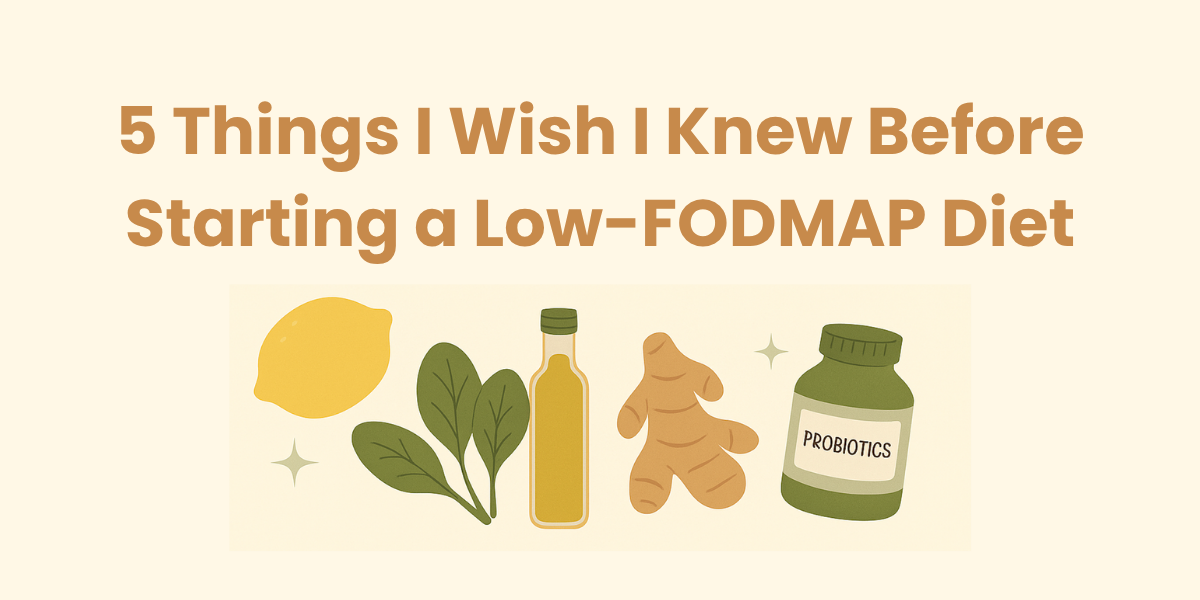When I first started the Low-FODMAP diet, I thought it would be a quick fix — cut out a few foods, calm my bloating, and move on with my life. Spoiler: it wasn’t that simple.
What I didn’t realize was that gut healing isn’t just about what you eat — it’s about how your body adjusts, detoxes, and rebuilds along the way.
If you’re starting your own FODMAP journey, here are five things I wish someone had told me before I began.
💫 1. Sometimes it gets worse before it gets better (and that’s okay)
The first week, I actually felt worse. My bloating flared up, I was exhausted, and my skin even broke out.
At first, I thought the diet wasn’t working — but what was really happening was bacterial die-off. When you have something like SIBO (Small Intestinal Bacterial Overgrowth), cutting out high-FODMAP foods can cause the “bad” bacteria to starve and release toxins as they die.
It’s not fun — but it’s temporary. I learned to support my body with hydration, electrolytes, gentle movement, and rest. Within a week or two, the fog lifted, and I felt clearer, lighter, and calmer.
If you’re in that phase right now — hang in there. You’re not doing anything wrong. Your gut is just recalibrating.
🥣 2. “Low-FODMAP” doesn’t mean “no-FODMAP”
In the beginning, I cut out everything — even foods that were technically fine. I was terrified of triggering symptoms.
But the goal isn’t to restrict forever — it’s to identify what your body actually reacts to. That means some FODMAPs will be perfectly fine for you, and others won’t.
The real healing came when I started reintroducing foods slowly and realized that balance (not elimination) was the point.
💧 3. Water, salt, and movement are just as important as food
When I was bloated and constipated, I thought the answer was “eat cleaner.” But it turned out my gut needed support in other ways too.
Simple habits — like drinking enough water, adding magnesium, and going for short walks after meals — made a massive difference.
Now, my daily routine includes warm water with lemon in the morning, a short stretch, and a 15-minute walk after dinner. These small habits do more for my digestion than I ever expected.
🍋 4. Reading ingredient labels becomes second nature
The first grocery trip took me an hour. I remember standing in the aisle asking ChatGPT “is garlic powder low FODMAP?”
Now I can spot hidden triggers a mile away. You’ll start to notice the sneaky ones — onion powder, honey, agave, apple juice concentrate — they’re everywhere.
But it gets easier, I promise. You’ll start memorizing your go-to brands, and before you know it, your pantry will feel totally safe.
🌸 5. Gut healing is not linear — and that’s normal
Some days, I feel amazing — other days, my stomach still gets puffy, and I have to remind myself how far I’ve come.
The Low-FODMAP diet isn’t a quick fix — it’s a tool. It helps you learn what your body needs and build a long-term relationship with your gut.
And honestly? The confidence that comes from understanding your body is worth every confusing food label and every awkward “I can’t eat that” dinner conversation.
💛 Final Thoughts
If you’re just starting out, give yourself grace. Healing your gut takes time, patience, and curiosity — but it’s absolutely worth it.
If you want help getting started, grab my 7-Day Low-FODMAP Meal Plan + Grocery List — it’s the exact guide I wish I had when I started.
You deserve to feel light, clear, and confident again. 🌿
